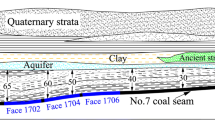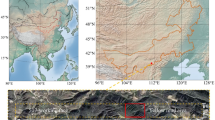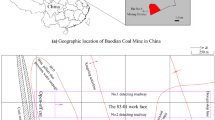Abstract
Raising the upper boundary of coal mining under thick Cenozoic unconsolidated layers has brought new challenges to the prediction and prevention of water and sand inrush from overlying sand and gravel aquifers in north China. The mechanism of water and sand inrush was studied based on an incident that occurred at working face 11071 in the Zhaogu No. 1 coal mine, in Henan Province. Geological and hydrogeological investigations in overlying strata indicated that intersections of horizontal confined aquifers and inclined bedrock surfaces, defined as skylight areas, allow water and sand from the aquifers to enter the workings. Geotechnical and physical simulation tests on overlying strata showed that mining-induced fractures in weathered bedrock were gradually enhanced by water and sand flowing under high pressure, leading to inrush incidents at the working faces. The empirical formula for estimating the requisite size of coal and rock pillars were modified by incorporating a term for protective thickness under skylight areas. The modified formula was successfully applied to the extraction of neighboring faces, proving its applicability in coal mines with similar geological and hydrogeological conditions.
Zusammenfassung
Die Erhöhung der hangenden Abbaugrenze unterhalb mächtiger unkonsolidierter känozoischer Sedimente in einem Kohlebergbau in Nord-China führte zu neuen Herausforderungen bei der Vorhersage von und Vorbeugung vor Wasser- und Sandeinbrüchen aus überlagernden kiesig/sandigen Grundwasserleitern. Die Mechanismen von Wasser- und Sandzutritten werden anhand eines Fallbeispiels aus der Zhaogu Nr. 1 Kohlemine (Henan Provinz, Ortsbrust 11071) untersucht. Geologische und hydrogeologische Untersuchungen der überlagernden Einheiten zeigten, das Kreuzungsbereiche von flach lagernden, gespannten Grundwasserleitern mit einfallendem Gebirgsbereichen, hier „skylight areas“ genannt, einen Zutritt von Wasser und Sand in die Grubenbaue begünstigten. Geotechnische und physikalische Simulationstests der überlagernden Einheiten lassen vermuten, dass bergbauinduzierte Kluftzonen im verwitterten Gebirge unter dem Einfluss der unter hohen Drücken auftretenden Wasser- und Sandflüsse sukzessive erweitert worden sind und somit einen Zufluss in die Grubenbaue begünstigten. Ein empirischer Ansatz zur Berechnung der Kohle- und Gesteinspfeilermaße wird in dieser Untersuchung durch einen zusätzlichen Term zur Beschreibung der notwendigen Mindestmächtigkeit unterhalb von „skylight areas“ erweitert. Die modifizierte Formel konnte erfolgreich bei Nachbarabbauen angewendet werden. Dies zeigt, dass solche Ansätze beim Kohleabbau unter ähnlichen geologischen Voraussetzungen verwendet werden können.
摘要
厚新生代松散层下提高煤炭开采上限为上覆砂砾含水层突水溃沙预测和防治提出新挑战。基于河南赵固一矿11071工作面突水溃沙案例研究突溃机理。地质和水文地质条件分析表明,水平含水层与倾斜基岩面交线为含水层水、沙溃入工作面的天窗。覆岩岩石力学和物理模拟试验表明,高压下水沙流使风化基岩采动裂隙扩展,导致突溃发生。通过增加天窗区保护厚度项,修正了煤岩柱尺寸计算经验公式。修正公式已成功应用于相邻工作面,证明了相似地质和水文地质条件下方法的适用性。
Resumen
La elevación del límite superior de la minería del carbón bajo gruesas capas cenozoicas no consolidadas ha traído nuevos desafíos a la predicción y prevención de la irrupción de agua y arena desde los acuíferos de grava y la arena superior en el norte de China. El mecanismo de la entrada de agua y arena se estudió en base a un incidente que ocurrió en la superficie de trabajo 11071 en la mina de carbón Zhaogu No 1, en la provincia de Henan. Las investigaciones geológicas e hidrogeológicas en los estratos suprayacentes indicaron que las intersecciones de los acuíferos confinados horizontales y las superficies rocosas inclinadas, definidas como áreas de tragaluz, permiten que el agua y la arena de los acuíferos ingresen al funcionamiento. Las pruebas de simulación geotécnica y física en estratos suprayacentes mostraron que las fracturas inducidas por la minería en el lecho de roca erosionada se agrandaron gradualmente por acción del agua y la arena que fluían a alta presión, lo que provocó incidentes en las superficies de trabajo. La fórmula empírica para estimar el tamaño requerido de los pilares de carbón y roca se modificó incorporando un término para un espesor de protección debajo de las áreas del tragaluz. La fórmula modificada se aplicó con éxito a la extracción de caras vecinas, lo que demuestra su aplicabilidad en minas de carbón con condiciones geológicas e hidrogeológicas similares.









Similar content being viewed by others
References
Bai M, Elsworth D (1990) Some aspects of mining under aquifers in China. Min Sci Tech 10:81–91
Chen LW, Zhang SL, Gui HR (2014) Prevention of water and quicksand inrush during extracting contiguous coal seams under the lowermost aquifer in the unconsolidated Cenozoic alluvium—a case study. Arab J Geosci 7(6):2139–2149
Chen LW, Feng XQ, Xie WP, Zeng W, Zheng ZY (2017) Using a fluid-solid coupled numerical simulation to determine a suitable size for barrier pillars when mining shallow coal seams beneath an unconsolidated, confined aquifer. Mine Water Environ 36(1):67–77
Huang QX, Wei BN, Zhang WZ (2010) Study of downward crack closing of clay aquiclude in shallowly buried coal seam. J Min Saf Eng 27(1):35–39 (Chinese)
Liu XS, Tan YL, Ning JG, Tian C, Wang J (2015) The height of water conducting fractured zones in longwall mining of shallow coal seams. Geotech Geol Eng 33:693–700
Miao XX, Cui XM, Wang JA, Xu JL (2011) The height of fractured water-conducting zone in undermined rock strata. Eng Geol 120:32–39
Qu YX, Xu XL, Shi MX, Wu ZL (1988) Engineering classification and fast estimation of the swelling potential for argillaceous rocks. Hydrogeol Eng Geol (5):13–16 (in Chinese)
Shi WH, Yang TH, Yu QL, Li Y, Liu HL, Zhao YC (2017) A study of water-inrush mechanisms based on geo-mechanical analysis and an in-situ groundwater investigation in the Zhongguan iron mine, China. Mine Water Environ 36(3):409–417
State Administration of Work Safety (2009) Provisions on prevention and control of water in coal mines. China Coal Industry Publ House, Beijing (in Chinese)
State Bureau of Coal Industry (2000) Pillar design and mining regulations under buildings, water, rails and major roadways. China Coal Industry Publ House, Beijing (in Chinese)
Sun YJ, Xu ZM, Dong QH, Liu SD, Gao RB, Jiang YH (2008) Forecasting water disaster for a coal mine under the Xiaolangdi reservoir. J China Univ Min Technol 18(4):516–520
Tan YL, Liu XS, Ning JG, Lu YW (2017) In situ investigations on failure evolution of overlying strata induced by mining multiple coal seams. Geotech Test J 40(2):244–257
Wang XZ, Xu JL, Zhu WB, Li YC (2012) Roof pre-blasting to prevent support crushing and water-inrush accidents. Int J Min Sci Technol 22(3):379–384
Wu Q, Liu YZ, Zhou WF, Li BY, Zhao B, Liu SQ, Sun WJ, Zeng YF (2015) Evaluation of water inrush vulnerability from aquifers overlying coal seams in the Menkeqing Coal Mine, China. Mine Water Environ 34(3):258–269
Xu YC (2008) Fluidity test on sand blended with clay. J China Coal Soc 33(5):496–499 (Chinese)
Xu YC, Liu SQ (2011) Study on method to set safety coal and rock pillar for fully mechanized top coal caving mining under water body. Coal Sci Technol 39(11):1–4 (Chinese)
Xu JL, Zhu WB, Wang XZ (2011) Study on water-inrush mechanism and prevention during coal mining under unconsolidated confined aquifer. J Min Saf Eng 28(3):333–339 (Chinese)
Yang WF, Xia XH, Zhao GR, Ji YB, Shen DY (2011) Overburden failure and the prevention of water and sand inrush during coal mining under thin bedrock. Min Sci Technol (China) 21(5):733–736
Yao BH, Bai HB, Zhang BY (2012) Numerical simulation on the risk of roof water inrush in Wuyang Coal Mine. Int J Min Sci Technol 22(2):273–277
Zhang JC, Peng SP (2005) Water-inrush and environmental impact of shallow seam mining. Eng Geol 48(8):1068–1076
Zhang JC, Shen BH (2004) Coal mining under aquifers in China: a case study. Int J Rock Mech Min 41(4):629–639
Zhang HQ, He YN, Tang CA, Ahmad B, Han LJ (2009) Application of an improved flow-stress-damage model to the criticality assessment of water-inrush in a mine: a case study. Rock Mech Rock Eng 42(6):911–930
Zhang DS, Fan GW, Ma LQ, Wang XF (2011) Aquifer protection during longwall mining of shallow coal seams: a case study in the Shendong Coalfield of China. Int J Coal Geol 86:90–196
Zhang W, Shang YJ, Qu YX, Sun YC, Lin DM, Wang KY (2013a) Grain size distribution of collapsed scraps of argillaceous rock and its relationship with expansibility: an experimental study. Rock Soil Mech 34(1):66–72 (Chinese)
Zhang YX, Tu SH, Bai QS, Li JJ (2013b) Overburden fracture evolution laws and water-controlling technologies in mining very thick coal seam under water-rich roof. Int J Min Sci Technol 23(5):693–700
Zhang GM, Zhang K, Wang LJ, Wu Y (2015) Mechanism of water inrush and quicksand movement induced by a borehole and measures for prevention and remediation. B Eng Geol Environ 74(4):1395–1405
Zhang GB, Zhang WQ, Wand CH, Zhu GL, Li B (2016) Mining thick coal seams under thin bedrock–deformation and failure of overlying strata and alluvium. Geotech Geol Eng 34(5):1553–1563
Zhang WQ, Li B, Zhang GB, Li ZL (2017) Investigation of water-flow fracture zone height in fully mechanized cave mining beneath thick alluvium. Geotech Geol Eng 35(4):1745–1753
Zhou DW, Wu K, Li L, Yu JW (2016) Impact of thick alluvial soil on a fractured water-conducting zone: an example from Huainan coal mine, China. J S Afr I Min Metall 116(5):431–440
Author information
Authors and Affiliations
Corresponding author
Rights and permissions
About this article
Cite this article
Xu, Y., Luo, Y., Li, J. et al. Water and Sand Inrush During Mining Under Thick Unconsolidated Layers and Thin Bedrock in the Zhaogu No. 1 Coal Mine, China. Mine Water Environ 37, 336–345 (2018). https://doi.org/10.1007/s10230-018-0539-8
Received:
Accepted:
Published:
Issue Date:
DOI: https://doi.org/10.1007/s10230-018-0539-8




